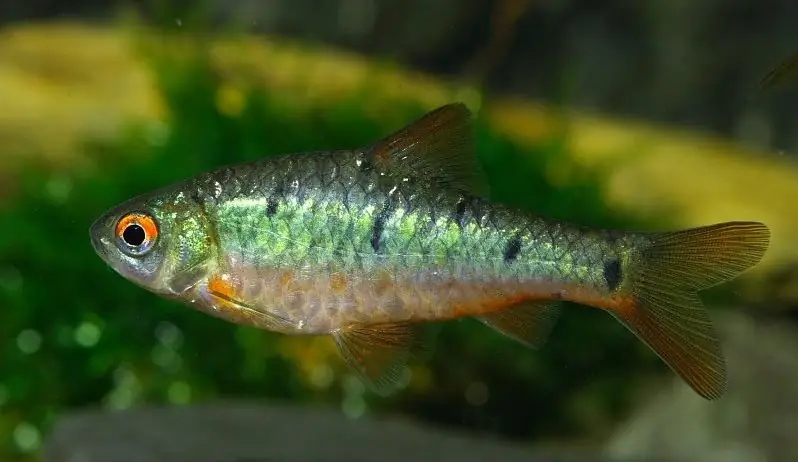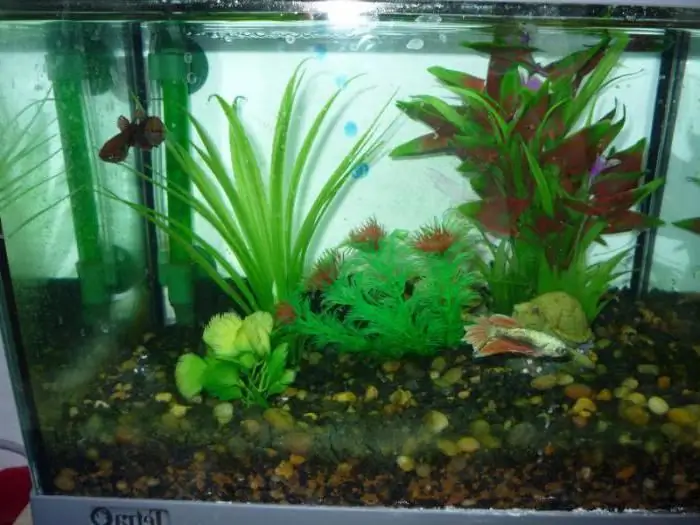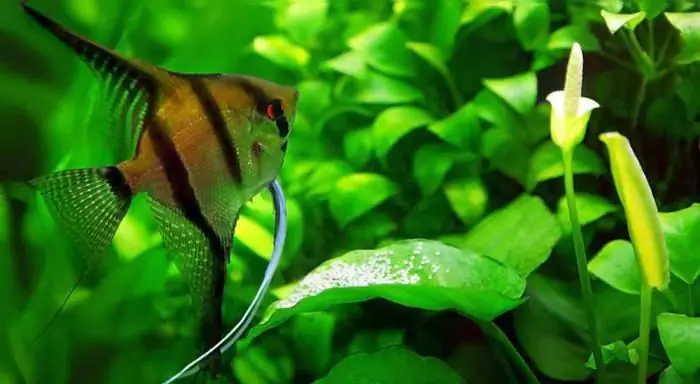2025 Author: Priscilla Miln | [email protected]. Last modified: 2025-01-22 17:55:19
Kalamoichty (ornamental snake fish) are of great interest to aquarists. They belong to an unusual order of multi-feathers, occupying a separate place among the known modern fish and fossil representatives of the fish family. Scientists have not been able to find the fossil ancestors of Kalamoiht Calabar.
Appearance

The body of this fish visually resembles a real snake: an elongated body, and modified diamond-shaped scales look like snake skin. At the same time, the snake fish has a flattened triangular head with a huge mouth and sharp teeth. All this also adds originality to the image of Kalamoikht. There are dorsal spines in the tail area. Their number ranges from 5 to 18 pieces.
The pelvic fins are either completely absent or shifted closer to the back of the body. Such a structure only enhances the "serpentine" appearance of this unusual aquatic animal.
Aquarium snake fish grows up to forty centimeters. She can live from 8 to 10 years. Black eyes and short spiracles give the aquarium snake a funny expression. For sounusual appearance, these fish become favorite inhabitants of domestic waters.
Calabar Calamoicht: content
For the successful maintenance of fish, large aquariums should be purchased, since kalamoichts need a large bottom area. The minimum water requirement for one fish is 100 liters. A group of fish (it is much more interesting to watch several individuals) will feel good in an aquarium with a volume of more than 200 liters.

The aquarium should always be tightly closed, as this snake fish is able to seep into any gap formed. It is also important to place various artificial shelters and driftwood in the aquarium. This helps the fish quickly adapt to a new place and get used to new living conditions. Calamoichts will especially like the leaves of the Indian almond, which act as a shelter and provide water conditioning in the aquarium.
These aquatic animals generally become more active in the evening or in diffused lighting. The fish begins to explore all corners of the aquarium in search of food. After that, it rises to the surface of the water, twisting into unusual rings. This is required in order to sometimes inhale atmospheric air, which helps to digest a hearty meal.
Water characteristics

Water temperature should not fall below 24 degrees. Kalamoicht Calabar is also sensitive to chemical indicators. So, the acceptable pH level is from 6.2 to 7.5, and GH, respectively, from 2 to 18. Veryit is important that there are no sharp fluctuations in these indicators.
In the process of acclimatization, as well as in case of a forced quick change of water, it is necessary to use air conditioners: "Biotopol", "Akclimol" or "Stresscoat". Kalamoichts do not tolerate formalin and organic dyes, as well as a sharp change in water salinity.
Adaptation Features
Most of the fish that are presented in the aquariums of pet stores are of natural origin. Therefore, after acquiring an exotic aquatic inhabitant, he needs pre-sale overexposure (sometimes up to 1 month) with further adaptation to captivity. But sellers quite often do not comply with these conditions, and many individuals die almost immediately after being released into a home aquarium.
That's why there is an opinion among aquarists that kalamoichts take root very poorly in home aquariums. Fortunately, this is not the case. He althy fish can easily adapt to new living conditions in decorative aquariums, if you follow the rules for keeping them.
A little about how to distinguish a he althy individual. When purchasing this fish, pay attention to its skin. If there are even small contrasting spots, then most likely the fish is sick, it will not live long.
Fish nutrition

Feeding kalamoihts does not cause any difficulties. He althy fish are happy to take various natural foods (even frozen ones). She especially loves large bloodworms. In the warm season, tadpoles andearthworms. Kalamoicht do not refuse small pieces of squid and shrimp. The fish is practically indifferent to dry food, they eat it with great reluctance.
Snake fish is a peaceful inhabitant of the aquarium, it does not offend its large neighbors. Large specimens for Kalamoicht will be specimens that cannot be swallowed. They get along well with any fish, but a trifle, in particular angelfish and neon, can be mistaken for food.
Reproduction of Kalamoihts
Fish reach sexual maturity in their third year of life. The main difference between a female and a male is the anal fin. The female has 9 rays, and the male has a fin consisting of 12-14 rays.
Reproduction of kalamoihts in captivity is possible, but hormonal stimulation will be required.
Spawning in natural conditions

Spawning in this fish begins during the flood of rivers. Males in the struggle for females arrange quite long fights. After the pair is determined and fertilization occurs, the female lays eggs in the very thick of vegetation or in coastal holes. The offspring begin to be born after two days, and after four days the fry are already crawling perfectly.
Fry of this fish have fringed external gills, allowing the young to survive in oxygen-depleted water. They feed on planktonic organisms, such as brine shrimp.
Unusual behavior
When satiated, Kalamoicht fish can behave unusually. There are good reasons for a rather non-standard assumption: theseafter a full meal, the inhabitants of the aquarium can play, and not only among themselves, but also with their owner.
It is generally accepted that the described fish are blind. But it's not. It's just that they quickly get used to a new place of residence among a team consisting of active and mobile neighbors. In doing so, the fish uses its sense of touch, smell and sight. By the way, they also see people in the room, so in the evening, kalamoihts can wait for their owners by the wall of the aquarium.
Recommended:
Large aquarium fish: names, description with photo, compatibility and content rules

Thousands of species of fish live in the waters of the earth's seas and oceans, in rivers and lakes of the continents. Amateur aquariums contain not only wild species, but also those modified by humans through selection and hybridization. Moreover, fish farmers do not refuse to admire not only delicate bright small handsome fish. Large aquarium fish also arouse their passionate interest
Aquarium fish algae eater: description, content features, care and reviews

Not all novice aquarists know that in addition to fish, snails, natural or artificial greenery and decorative ornaments, an algae-eating fish should settle in every underwater kingdom. About why the presence of these inhabitants is so necessary, we will try to tell in this article
Tetra aquarium fish: photos, types, content

Aquarium fish amaze with their diversity. Everyone can choose the best option for themselves. So, tetra fish, the photos of which are presented, are suitable for beginner aquarists or those who do not have time to devote a lot of time to pets. Adults and children enjoy watching these living, moving and bright creatures
Pecilia: reproduction and care at home. Pecilia aquarium fish: description, content

This article will tell you about the platy in sufficient detail. The reader will get acquainted with all the necessary information related to habitats, feeding habits and the appearance of such an interesting inhabitant of the underwater world as pecilia. Reproduction and breeding at home will also be covered in separate sections
Fish domestic. Types of aquarium fish, compatibility and content

There are several thousand varieties of aquarium fish in the world. Small and large, predatory and carnivorous, bright and not very bright, with lush tails, long mustaches and bizarre fins - all these inhabitants of the underwater world attract with their beauty, and watching their unhurried movements in the water column helps to relax and take a break from everyday problems

